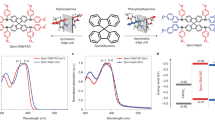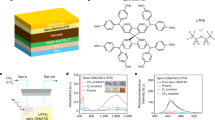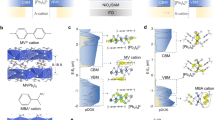Abstract
Spiro-OMeTAD, one of the most widely used hole-transport materials (HTMs) in optoelectronic devices, typically requires chemical doping with a lithium compound (LiTFSI) to attain sufficient conductivity and efficient hole extraction. However, the doping step requires an activation process that comprises exposure of the blend films to an ambient atmosphere. Additionally, the lithium dopant induces crystallization, and its hygroscopic nature negatively impacts device performance and lifetime. Here we report a facile approach based on the incorporation of a low-cost alkylthiol additive (1-dodecanethiol, DDT) in the spiro-OMeTAD HTM. We discover that DDT provides a more efficient and controllable doping process with significantly reduced doping duration, enabling the HTM to achieve comparable performance before air activation. The coordination between DDT and LiTFSI increases the concentration of dopants in the HTM bulk, reduces their accumulation at interfaces, and enhances the structural integrity of the HTM under wetting, heat and light stress. We fabricate perovskite solar cells using DDT-treated spiro-OMeTAD as the HTM. Our best devices exhibit a certified power conversion efficiency of 23.1%. Furthermore, the devices can retain 90% of peak performance under continuous illumination for 1,000 h. Our findings represent an important step forward in the production of doped spiro-OMeTAD, as well as its reliable application and future device commercialization.
This is a preview of subscription content, access via your institution
Access options
Access Nature and 54 other Nature Portfolio journals
Get Nature+, our best-value online-access subscription
$29.99 / 30 days
cancel any time
Subscribe to this journal
Receive 12 print issues and online access
$209.00 per year
only $17.42 per issue
Buy this article
- Purchase on Springer Link
- Instant access to full article PDF
Prices may be subject to local taxes which are calculated during checkout






Similar content being viewed by others
Data availability
The data that support the plots within this paper and other finding of this study are available from the corresponding author upon reasonable request.
References
Salzmann, I., Heimel, G., Oehzelt, M., Winkler, S. & Koch, N. Molecular electrical doping of organic semiconductors: fundamental mechanisms and emerging dopant design rules. Acc. Chem. Res. 49, 370–378 (2016).
Snaith, H. J. & Gratzel, M. Enhanced charge mobility in a molecular hole transporter via addition of redox inactive ionic dopant: implication to dye-sensitized solar cells. Appl. Phys. Lett. 89, 262114 (2006).
Burschka, J. et al. Sequential deposition as a route to high-performance perovskite-sensitized solar cells. Nature 499, 316–319 (2013).
Jiang, Q. et al. Surface passivation of perovskite film for efficient solar cells. Nat. Photon. 13, 460–466 (2019).
Yoo, J. J. et al. Efficient perovskite solar cells via improved carrier management. Nature 590, 587–593 (2021).
Min, H. et al. Perovskite solar cells with atomically coherent interlayers on SnO2 electrodes. Nature 598, 444–450 (2021).
Li, N. X. et al. Liquid medium annealing for fabricating durable perovskite solar cells with improved reproducibility. Science 373, 561–567 (2021).
Wang, X. M. et al. Manipulating the electrical properties of Sb2(S,Se)3 film for high-efficiency solar cell. Adv. Energy Mater. 10, 2002341 (2020).
Tang, R. F. et al. Hydrothermal deposition of antimony selenosulfide thin films enables solar cells with 10% efficiency. Nat. Energy 5, 587–595 (2020).
Zhao, Y. Q. et al. Regulating energy band alignment via alkaline metal fluoride assisted solution post-treatment enabling Sb2(S,Se)3 solar cells with 10.7% efficiency. Adv. Energy Mater. 12, 2103015 (2022).
Kong, J. et al. CO2 doping of organic interlayers for perovskite solar cells. Nature 594, 51–56 (2021).
Tan, B. et al. LiTFSI-free Spiro-OMeTAD-based perovskite solar cells with power conversion efficiencies exceeding 19%. Adv. Energy Mater. 9, 1901519 (2019).
Schloemer, T. H., Christians, J. A., Luther, J. M. & Sellinger, A. Doping strategies for small molecule organic hole-transport materials: impacts on perovskite solar cell performance and stability. Chem. Sci. 10, 1904–1935 (2019).
Ren, G. H. et al. Strategies of modifying Spiro-OMeTAD materials for perovskite solar cells: a review. J. Mater. Chem. A 9, 4589–4625 (2021).
Zhao, X., Kim, H. S., Seo, J. Y. & Park, N. G. Effect of selective contacts on the thermal stability of perovskite solar cells. ACS Appl. Mater. Interfaces 9, 7148–7153 (2017).
Li, Z. et al. Extrinsic ion migration in perovskite solar cells. Energy Environ. Sci. 10, 1234–1242 (2017).
Hu, M. et al. Solvent engineering of a dopant-free Spiro-OMeTAD hole-transport layer for centimeter-scale perovskite solar cells with high efficiency and thermal stability. ACS Appl. Mater. Interfaces 12, 8260–8270 (2020).
Hawash, Z., Ono, L. K. & Qi, Y. B. Recent advances in Spiro-MeOTAD hole transport material and its applications in organic-inorganic halide perovskite solar cells. Adv. Mater. Interfaces 5, 1700623 (2018).
Yin, X. X., Song, Z. N., Li, Z. F. & Tang, W. H. Toward ideal hole transport materials: a review on recent progress in dopant-free hole transport materials for fabricating efficient and stable perovskite solar cells. Energy Environ. Sci. 13, 4057–4086 (2020).
Wang, S. Y. et al. Efficient and stable all-inorganic Sb2(S,Se)3 solar cells via manipulating energy levels in MnS hole transporting layers. Sci. Bull. 67, 263–269 (2022).
Fang, R. P., Xu, J. T. & Wang, D. W. Covalent fixing of sulfur in metal-sulfur batteries. Energy Environ. Sci. 13, 432–471 (2020).
Liang, Y. L., Tao, Z. L. & Chen, J. Organic electrode materials for rechargeable lithium batteries. Adv. Energy Mater. 2, 742–769 (2012).
Lim, D. C. et al. Emissive nanoclusters based on subnanometer-sized Au38 cores for boosting the performance of inverted organic photovoltaic cells. Adv. Energy Mater. 5, 1500393 (2015).
Ouyang, J. Y. & Xia, Y. J. High-performance polymer photovoltaic cells with thick P3HT:PCBM films prepared by a quick drying process. Sol. Energy Mater. Sol. C 93, 1592–1597 (2009).
1-Dodecanethiol (Sigma-Aldrich); https://www.sigmaaldrich.com/US/en/product/aldrich/471364
Harwell, J. R. et al. Probing the energy levels of perovskite solar cells via Kelvin probe and UV ambient pressure photoemission spectroscopy. Phys. Chem. Chem. Phys. 18, 19738–19745 (2016).
Jung, M. C., Raga, S. R., Ono, L. K. & Qi, Y. B. Substantial improvement of perovskite solar cells stability by pinhole-free hole transport layer with doping engineering. Sci. Rep. 5, 9863 (2015).
Abate, A. et al. Lithium salts as ‘redox active p-type dopants for organic semiconductors and their impact in solid-state dye-sensitized solar cells. Phys. Chem. Chem. Phys. 15, 2572–2579 (2013).
Calio, L., Salado, M., Kazim, S. & Ahmad, S. A generic route of hydrophobic doping in hole transporting material to increase longevity of perovskite solar cells. Joule 2, 1800–1815 (2018).
Li, Z. et al. Acid additives enhancing the conductivity of Spiro-OMeTAD toward high-efficiency and hysteresis-less planar perovskite solar cells. Adv. Energy Mater. 7, 1601451 (2017).
Li, Y., Zaluzhna, O. & Tong, Y. Y. J. Identification of a source of size polydispersity and its solution in Brust-Schiffrin metal nanoparticle synthesis. Chem. Commun. 47, 6033–6035 (2011).
Li, X. B. et al. Mechanistic insights into the interface-directed transformation of thiols into disulfides and molecular hydrogen by visible-light irradiation of quantum dots. Angew. Chem. Int. Ed. 53, 2085–2089 (2014).
Mandal, B. & Basu, B. Recent advances in S-S bond formation. RSC Adv. 4, 13854–13881 (2014).
Tan, K. Y. D., Teng, G. F. & Fan, W. Y. Photocatalytic transformation of organic and water-soluble thiols into disulfides and hydrogen under aerobic conditions using Mn(CO)5Br. Organometallics 30, 4136–4143 (2011).
Zeynizadeh, B. Oxidative coupling of thiols to disulfides with iodine in wet acetonitrile. J. Chem. Res. 2002, 564–566 (2002).
Saygili, Y. et al. Revealing the mechanism of doping of Spiro-MeOTAD via Zn complexation in the absence of oxygen and light. ACS Energy Lett. 5, 1271–1277 (2020).
Hawash, Z., Ono, L. K., Raga, S. R., Lee, M. V. & Qi, Y. B. Air-exposure induced dopant redistribution and energy level shifts in spin-coated Spiro-MeOTAD films. Chem. Mater. 27, 562–569 (2015).
Hawash, Z., Ono, L. K. & Qi, Y. B. Moisture and oxygen enhance conductivity of LiTFSI-doped Spiro-MeOTAD hole transport layer in perovskite solar cells. Adv. Mater. Interfaces 3, 1600117 (2016).
Jiang, Q. et al. Planar-structure perovskite solar cells with efficiency beyond 21%. Adv. Mater. 29, 1703852 (2017).
Zhao, Y. C. et al. Perovskite seeding growth of formamidinium-lead-iodide-based perovskites for efficient and stable solar cells. Nat. Commun. 9, 1607 (2018).
Wang, L. G. et al. A Eu3+-Eu2+ ion redox shuttle imparts operational durability to Pb-I perovskite solar cells. Science 363, 265–270 (2019).
Seo, J. Y. et al. Novel p-dopant toward highly efficient and stable perovskite solar cells. Energy Environ. Sci. 11, 2985–2992 (2018).
Jeon, N. J. et al. A fluorene-terminated hole-transporting material for highly efficient and stable perovskite solar cells. Nat. Energy 3, 682–689 (2018).
Malinauskas, T. et al. Enhancing thermal stability and lifetime of solid-state dye-sensitized solar cells via molecular engineering of the hole-transporting material Spiro-OMeTAD. ACS Appl. Mater. Interfaces 7, 11107–11116 (2015).
Rolston, N. et al. Mechanical integrity of solution-processed perovskite solar cells. Extreme Mech. Lett. 9, 353–358 (2016).
Kim, H. S., Seo, J. Y. & Park, N. G. Impact of selective contacts on long-term stability of CH3NH3Pbl3 perovskite solar cells. J. Phys. Chem. C 120, 27840–27848 (2016).
Kim, S. G. et al. Capturing mobile lithium ions in a molecular hole transporter enhances the thermal stability of perovskite solar cells. Adv. Mater. 33, 2007431 (2021).
Turren-Cruz, S. H., Hagfeldt, A. & Saliba, M. Methylammonium-free, high-performance, and stable perovskite solar cells on a planar architecture. Science 362, 449–453 (2018).
Yang, G. et al. Effective carrier-concentration tuning of SnO2 quantum dot electron-selective layers for high-performance planar perovskite solar cells. Adv. Mater. 30, 1706023 (2018).
Liu, X. et al. Exploring inorganic binary alkaline halide to passivate defects in low-temperature-processed planar-structure hybrid perovskite solar cells. Adv. Energy Mater. 8, 1800138 (2018).
Liu, X. et al. Improvement of Cs-(FAPbI3)0.85(MAPbBr3)0.15 quality via DMSO-molecule-control to increase the efficiency and boost the long-term stability of 1-cm2 sized planar perovskite solar cells. Sol. RRL 3, 1800338 (2019).
Li, N. et al. Cation and anion immobilization through chemical bonding enhancement with fluorides for stable halide perovskite solar cells. Nat. Energy 4, 408–415 (2019).
Peng, J. et al. Nanoscale localized contacts for high fill factors in polymer-passivated perovskite solar cells. Science 371, 390–395 (2021).
Peng, J. et al. A universal double-side passivation for high open-circuit voltage in perovskite solar cells: role of carbonyl groups in poly(methyl methacrylate). Adv. Energy Mater. 8, 1801208 (2018).
Acknowledgements
This work was supported by the Australian Government through the Australian Renewable Energy Agency (grant no. RND0751). X.H. acknowledges financial support by the Australian Research Council (ARC) Future Fellowship (FT190100756). X.L. acknowledges support from the Australian Centre of Advanced Photovoltaics (ACAP) for his Postdoc Fellowship (project ID RG193402-G). Responsibility for the views, information or advice expressed herein is not accepted by the Australian Government. We acknowledge the use of the facilities at the Solid State and Elemental Analysis Unit, and the Australian microscopy and microanalysis research facilities at the Electron Microscope Unit, University of New South Wales (UNSW). We acknowledge the assistance of B. Gong on the TOF-SIMS measurements and discussions. We acknowledge the assistance of Y. Yao on the AFM measurements and discussions. We acknowledge the assistance of M. Lee on the KPFM measurements. We acknowledge the assistance of Y. Wang on the preparation of NMR samples. We acknowledge the assistance of C. Qian on the fabrication of Sb2(S,Se)3 solar cells.
Author information
Authors and Affiliations
Contributions
X.L. conceived the idea of the project, designed the experiments, analysed the data and wrote the manuscript. X.L. performed the fabrication, optimization and characterization of the films and solar cells. X.L., Y.L. and W.-H.Z. contributed to the perovskite using a two-step method. X.L., B.Z., L.S. and M.Z. contributed to the characterization of the films and stability tests of the devices. X.L. and B.Z. contributed to UV–vis absorption spectra measurements. X.L., B.Z., J.X., S.Z. and X.H. contributed to NMR characterization of the films and the mechanism analysis of the devices. X.L., B.Z. and Z.L. performed the XRD and SEM characterizations. B.Z. and E.C. characterized the AFM process. J.S.Y., E.C. and J.S. carried out the KPFM measurements and analysed the data. X.L. performed the space-charge-limited current measurements and analysed the data. X.L., K.S. and M.Z. performed the PL measurements and analysed the data. X.L. and J.H. performed the EIS measurements and analysed the data. X.L. performed the FTIR measurements and analysed the data. X.L. analysed the TOF-SIMS data. C.L. contributed to the anti-reflection layer process. M.H. and J.P. assisted with the fabrication of large-area PSCs. All authors commented on the final version of the manuscript. X.H. and M.G. supervised the project, advised on its direction and helped prepare the manuscript.
Corresponding authors
Ethics declarations
Competing interests
UNSW has filed an international PCT patent (Application No. PCT/AU2021/050147) related to the subject matter of this manuscript. The authors declare no competing interests.
Peer review
Peer review information
Nature Photonics thanks Nazario Martin, Changduk Yang and the other, anonymous, reviewer(s) for their contribution to the peer review of this work.
Additional information
Publisher’s note Springer Nature remains neutral with regard to jurisdictional claims in published maps and institutional affiliations.
Extended data
Supplementary information
Supplementary Information
Supplementary Fig. 1, KPFM results of different HTMs. Supplementary Fig. 2, UPS results of different HTMs. Supplementary Fig. 3, NMR results of different HTMs. Supplementary Fig. 4, UV-vis absorption results of different HTMs. Supplementary UV-vis absorption results discussion. Supplementary Fig. 5, SEM results of different HTMs. Supplementary Fig. 6, Photographs of different HTMs exposed in air. Supplementary Fig. 7, FTIR results of different HTMs. Supplementary FTIR results discussion. Supplementary Fig. 8, Electrical characterization results of different HTMs. Supplementary Fig. 9, Impact of DDT and air activation on Cs0.05(FAPbI3)0.85(MAPbBr3)0.15 devices via solvent engineering. Supplementary Fig. 10, EQE results of DDT-treated Cs0.05(FAPbI3)0.85(MAPbBr3)0.15 devices via solvent engineering. Supplementary Fig. 11, J–V curves of the DDT-treated Cs0.05FAXMA1 − XPbI3 device (0.09 cm2) via sequential deposition. Supplementary Fig. 12, EQE results of DDT-treated Cs0.05FAXMA1 − XPbI3 devices via sequential deposition. Supplementary Fig. 13, J–V curves of the DDT-treated Cs0.05FAXMA1 − XPbI3 device (1.0 cm2) via sequential deposition. Supplementary Fig. 14, Impact of DDT and DDS on Cs0.05(FAPbI3)0.85(MAPbBr3)0.15 devices via solvent engineering. Supplementary Fig. 15, Stability results of DDT-treat devices and DDS-treated devices in ambient air. Supplementary Fig. 16, AFM results of different HTMs. Supplementary Fig. 17, XRD results of different HTMs-based devices. Supplementary Fig. 18, AFM result of control HTM after wetting stress. Supplementary Fig. 19, TOF-SIMS results of control and DDT-treated devices after wetting stress. Supplementary Fig. 20, TOF-SIMS results of control and DDT-treated devices after thermal stress. Supplementary Fig. 21, J–V curve of thermal-aged device after re-depositing new HTM. Supplementary Fig. 22, Stability results of control and DDT-treated FA0.9Cs0.1PbI3 devices after thermal stress. Supplementary stability results discussion. Supplementary Fig. 23, TOF-SIMS results of control and DDT-treated devices after light stress. Supplementary Fig. 24, J–V curve of light-aged device after re-depositing new HTM. Supplementary Fig. 25, Impact of DDT on PTAA-based Cs0.05(FAPbI3)0.85(MAPbBr3)0.15 devices via solvent engineering. Supplementary Fig. 26, EQE results of PTAA-based Cs0.05(FAPbI3)0.85(MAPbBr3)0.15 devices via solvent engineering. Supplementary Fig. 27, PL results of different PTAA-based HTMs. Supplementary Fig. 28, AFM results of different PTAA-based HTMs. Supplementary Table 1, Reported top efficiencies of PSCs since 2012. Supplementary Table 2, Reported top efficiencies of Sb2(S,Se)3 solar cells since 2020. Supplementary Table 3, Photovoltaic parameters of DDT-treated cells prepared by solvent engineering. Supplementary Table 4, Photovoltaic parameters of DDT-treated cells (0.09 cm2) prepared by sequential deposition. Supplementary Table 5, Photovoltaic parameters of DDT-treated cells (1.0 cm2) prepared by sequential deposition. Supplementary Table 6, Performance of DDS-treated cells and DDT-treated cells before and after ageing in ambient air. Supplementary Table 7, Performance of ODT-treated cells before and after ageing in ambient air. Supplementary Table 8, Performance of control and DDT-treated Cs0.05FAXMA1 − XPbI3 cells (0.09 cm2) before and after ageing in ambient air. Supplementary Table 9, Performance of DDT-treated Cs0.05FAXMA1 − XPbI3 cells (1.0 cm2) before and after ageing in ambient air. Supplementary Table 10, Performance of control and DDT-treated cells before and after wetting stress. Supplementary Table 11, Performance of control and DDT-treated cells before and after thermal stress. Supplementary Table 12, Performance of control and DDT-treated FA0.9Cs0.1PbI3 cells before and after thermal stress. Supplementary Table 13, Performance of control and DDT-treated cells before and after light stress. Supplementary Table 14, Photovoltaic parameters of control and DDT-treated Sb2(S,Se)3 cells. Certification reports.
Rights and permissions
Springer Nature or its licensor (e.g. a society or other partner) holds exclusive rights to this article under a publishing agreement with the author(s) or other rightsholder(s); author self-archiving of the accepted manuscript version of this article is solely governed by the terms of such publishing agreement and applicable law.
About this article
Cite this article
Liu, X., Zheng, B., Shi, L. et al. Perovskite solar cells based on spiro-OMeTAD stabilized with an alkylthiol additive. Nat. Photon. 17, 96–105 (2023). https://doi.org/10.1038/s41566-022-01111-x
Received:
Accepted:
Published:
Issue Date:
DOI: https://doi.org/10.1038/s41566-022-01111-x
This article is cited by
-
Polymer-acid-metal quasi-ohmic contact for stable perovskite solar cells beyond a 20,000-hour extrapolated lifetime
Nature Communications (2024)
-
Stabilizing semi-transparent perovskite solar cells with a polymer composite hole transport layer
Nano Research (2024)
-
Engineering the buried interface in perovskite solar cells via lattice-matched electron transport layer
Nature Photonics (2023)



